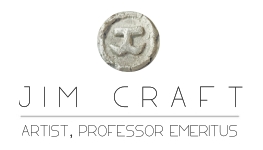Artist Statement
As in life, my work can be both lighthearted and yet serious, but important themes will often appear for those who have eyes to see.
Jim Craft | Professor Emeritus | Palm Beach Atlantic University
Years ago while doing my graduate work, I was instructed that meta-narratives were dead; maybe even an act of aggression and power play. The relativism of the post-modern world is silly and confusing. All I ever wanted to do was tell stories with the beautiful human figure – the imago dei – and employ images to say the things that cannot be spoken, things that are true, the simple but sacramental events of love, sacrifice and joy, family, and especially the great mystery of the Husband and Bride.
I was much encouraged after a research journey to study the delightfully charming and sometimes terrifying narratives of Romanesque church art along the ancient French pilgrimage routes – especially at Vézelay, Autun, Conques, and Moissac. These stone reliefs are some of the first celebrations of narrative art emerging after the Second Council of Nicaea 787, specifically the Fourth Session (October 1, 787), which proved the lawfulness of icon veneration as drawn from Exodus 25:19; Numbers 7:89; Hebrews 9:5; Ezekiel 41:18, and Genesis 31:34. The Fifth Session (October 4, 787) declared further that iconoclasm was a heresy arising originally from misguided Talmudic teachings adopted by Saracens, and Manicheans. The Gnostic notion that the material world is inherently evil is anti-incarnational.
The brilliant twelfth century Abbott Suger and inventor of the Gothic style writes,
The dull mind rises to the truth through material things,
And rises from its submersion when it sees the light.
More encouragement came from contemporary art critic Daniel Siedell’s valuable insights regarding ‘the economy of the icon’ in his scholarly work, “God in the Gallery”. His thesis addressing the sacred “other” in art stands counter to much contemporary criticism.
However, wholeheartedly embracing the Truth and creating images referencing Biblical events that hold layers of sacred meaning remains a most formidable task. Marc Cardinal Ouellet says it best, “The manner in which this event occurs is so profound and mysterious that we cannot adequately express it with our earthly categories. The Holy Spirit, who ‘specializes’ in union within distinction, is its artisan and permanent mediator.”
I am tremendously humbled realizing my own art follows a tradition of titans. My work is both lighthearted and grave, but the essential and profound relational themes will appear for those who have eyes to see.
